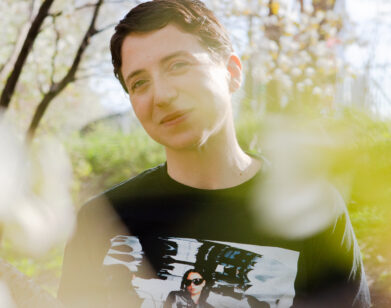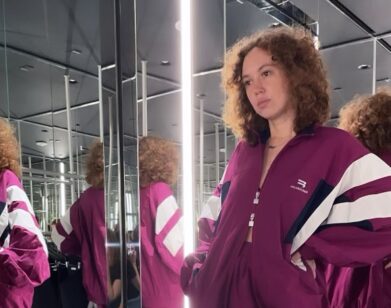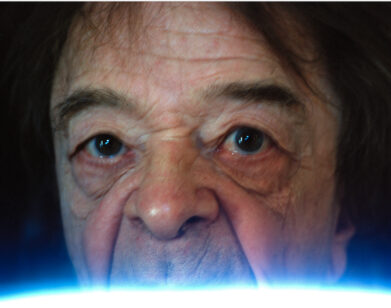PANEL
Directors Micaela Durand and Daniel Chew Want You to Torrent Their Films
For filmmakers Daniel Chew and Micaela Durand, the city is itself a character. In the creative duo’s triptych of short films, First, Negative Two, and 38, they explore the eery, simultaneous solitude and connectedness of New York City in a hyper-online age. “The internet is such a place of transit,” Durand explains. “People come through and go, and we liked mirroring that to the architecture of New York.” A couple of weeks ago, after an L.A. premiere of the trilogy presented by Mezzanine and Triple Canopy, the cult writer Chris Kraus sat them down to deliver her burning questions on dystopia, non-actors, and downtown gentrification. The following is a slightly abridged version of that conversation.
———
CHRIS KRAUS: My first question was going to be about the way you deal with the phenomenon of connectivity. The film is like every contemporary TV show and movie where people are on their iPads and phones all the time, and yet the world still looks like the old world. It doesn’t really look like the world that we live in because somehow the devices kind of recede rather than protrude. How intentional was it and were there other references for you that shaped your approach to this?
DANIEL CHEW: I think one of the reasons why we came to showing the internet without showing the internet is that in a lot of narrative films, the implications of the internet were never true to how we actually felt like we experienced film. Sometimes it was protruding too much where it was, like, text bubbles or a shot of an interface, where it didn’t really feel like the experience that we were having. it felt like it was from someone who was older and didn’t grow up with the internet like we did. So we were like, “We need to try to depict the internet in a way that feels true to our experience.” We touched on the invisible architecture of the technology that structures our life. And Keller Easterling and her theories about standardization and the world, this invisible architecture of our lives, was one of the influences.
MICAELA DURAND: And the internet is such a place of transit. People come through and go, and we liked mirroring that to the architecture of New York. We also wanted to make films about the internet that are excluded from the canon of internet films, which tend to be really moralistic. We’re really opposed to moralistic tales about anything. I mean, I enjoy watching Unfriended: Dark Web, but we wanted to capture how the internet can go from being really boring to erotic or just very lonely.
KRAUS: All of the environments in your movies are very built environments and there’s no escape from them. You feel the control and the surveillance in the workplace in the second film. Even when they’re dancing, that’s a combination of control and freedom. It is the most dystopian vision. I don’t know if that’s a question or not. Here’s the second question, which is that you went to film school and then you became visual artists, and then you were involved in what people used to refer to as internet art for about a decade, but then you migrated back into film. Did you feel yourself coming up against limits in visual art or film?
CHEW: I think why we were initially attracted to internet art as opposed to film was that we were going to film school at NYU and everyone who was there was making their senior films on their family budget of $30,000. We wanted a more immediate way of creating things, and one way to do that very cheaply was to make art on the internet.
DURAND: Because we didn’t have $30,000.
CHEW: Internet art was very much this new medium that everyone was trying to figure out. It was the novelty of the internet as this separate thing from our lives, but we were really interested in observing how it interacted within our physical lives, and the way the world was being reproduced online in some way. At one point during Web 1.0, the internet was this wild west where you could escape identity markers. But then as the internet developed into Web 2.0, markers of class and gender and sexuality came back into technology and the internet. We were more interested in how the internet was dictating sociality and our physical selves.
DURAND: Internet art is also accessible, and that’s what drew us to film. It’s exploring race and sexuality through a medium that people can torrent and watch in their bedroom.
CHEW: I think the narrative form lends itself to the lived experiences that we were trying to explore better than visual art.
KRAUS: Yeah. The way the actors appear in your film is really striking. I know you cast your friends. It wasn’t a regular casting process, and yet your friends are really excellent performers who capture these moments of doubt and vulnerability and desire and sensitivity. How did you work with the actors?
DURAND: We cast Mae [Wangmo], who’s in First, from Facebook. I looked through a lot of Facebook and Instagram and we cast the first two protagonists from that. We also auditioned real actors, but there was something about non-actors that was special to us. We write characters as a kind of sketch and then we get to know the actors and fill in the sketch to create a real protagonist. The third film, 38, actually starred a close friend of mine, Curie Choi, and the other woman is played by Alicia [Novella Vasquez], who’s someone that I randomly happened upon on Instagram and she followed me back. She just presented herself in a way that I was really transfixed by. We wanted to make a portrait of New York, and so many of our friends are in the art and literary world, so it makes sense to cast them.
CHEW: And with people like Eric [Lee] or Mae, they were reckoning with the same issues in their actual lives. So a lot of their reactions that you see are very true. The club scene where Mae just walks into the club, that was actually her first time at the club because we snuck her in, and she really was that amazed.
DURAND: We learned her real age was younger than what we thought. I begged the guy who ran that club to let us in.
KRAUS: Do you do a lot of takes?
CHEW: So we do have a very loose script, and we’ll do a few takes with the lines from the script. With non-actors, you really just have to let their personality fill the role. So we’ll just give them prompts after they get used to the pacing of what the scene would be, and we do maybe three takes with sides and then three takes with improv. We edit in a way that allows for it to be seamless. We also use a lot of voiceover.
KRAUS: Eric K. Yue is the cinematographer for all three of them and he seems like he’s the missing third. What he does seems very integral to the films being what they are.
DURAND: Yeah, Eric’s amazing. He’s just a really good friend of ours, and we met him actually before First. We’d actually written a feature that we didn’t get funding for that involved a love triangle, and he shot a mood film reel for it. He just gets it. I think we share a lot of the same references. He also grew up in New York and it was really important for us to show that.
KRAUS: Even though First was made with no money, it’s very controlled and there’s a really high production value. I know that you even had a colorist. I mean, there’s nothing guerilla filmmaking about it. It’s extremely intentional and controlled.
CHEW: We made that film for $600 with the borrowed equipment and borrowed time, basically, and it got into Rotterdam Film Festival. So we applied for an emergency grant to get it color corrected. That was very important for us because there’s not much dialogue in our films, so we needed color to match the interiority of the characters.
KRAUS: Yeah. The other thing I wanted to ask you about is that in all of your films, the main characters are Asian, and yet there’s none of the usual Asian American stereotypes. It’s not central to it. The people are just urban subjects who are also Asian. Was that something you were thinking about?
DURAND: Yeah, it was important for us to cast people who look like us. Even though I’m not Asian, I get mis-raced a lot for being Asian. I’m half Argentine and half Peruvian. But it was a conscious decision to have people who look like us go through things that are not the stereotypical drama of, like, they’re coming out and they’re Asian.
CHEW: But we were still very sensitive to the fact that they do go through certain experiences because they are racialized. As I said before, the internet recreates all the social aspects of the real world, and race does play a factor in that.
KRAUS: The steady cam in the second film is really incredible. Chinatown becomes almost like a character in the film. All three films are in Chinatown, but that one felt like you were splicing between the 19th and the 20th and the 21st century in that film. What were you going for with that?
CHEW: I don’t know if everyone knows, but Chinatown has been the hip gentrified neighborhood of New York for the past 15 or 20 years. And we were definitely part of that Chinatown gallery scene, so it was an honest reflection of our experience in New York in that way. But I also grew up going to Chinatown in San Francisco, so Chinatown is a very integral experience of my childhood. It was interesting for me to be on both sides of understanding the old Chinatown that’s being gentrified, but also being part of the new Chinatown that gentrified the old one. There’s a disconnect in assimilating in both those spaces.
DURAND: And in that scene, we go into Doyers Street, which was once a place the mafia was known to hang out and now it’s become this selfie architecture touristic street. We wanted to mirror the way that when you go online you can be so hooked on a thing or a person and then become completely distracted and go to something else. So we were obsessed with the idea of the shop and searched for the street for so long and it finally worked out.
KRAUS: Chinatown was originally developed as a place of immigrant urban poverty, like the Lower East Side. And it is remarkable, the way in the Chinatown town shop you feel the residues of that history.
CHEW: Yeah, even the man singing Chinese opera was genuine happenstance.
KRAUS: This is the second to last question. In the last film, 38, Curie Choi’s character is reeling from heartbreak. The end of the trilogy sees Curie’s escape from the heart of the city out to the beach, which made me think of Eric Rohmer Six Moral Tales, half a century later. Was he a reference for you?
CHEW: Yeah, Eric Rohmer is definitely a reference for us. The human drama that he captures through these phenomenal conversations is something that we look to. And Hong Sang-soo, who also takes a lot from Eric Rohmer, is also a really big reference for us.
DURAND: Especially his film, On a Beach at Night Alone, which is about this woman dealing with an affair in which she was the other woman, and her emotion ranges so much from being cold and distant to rage.
KRAUS: Are you making another film now?
DURAND: We are. We’re writing our first feature film.
KRAUS: Congratulations.
DURAND: We’re in the final draft. It’s about a woman who’s a complicated character, an unlikable character, which is our favorite type of character. She’s in her late 30s. She’s a Japanese interpreter who lives in New York, but she’s also an aspiring writer. She’s reeling from this breakup with a literary editor who’s very adored in her community, more adored than she is because he has a lot of connections. Basically, all this gossip unfurls where she becomes the center of this storm in New York City. The gossip kind of creeps into her job and she’s trying to regain her sense of self and understand the truth while she’s interpreting other people’s truths.
CHEW: We want to really continue our formal experimentation in film, but in a new, different way, using subtitles and translation as a continuation and interpretation of what we were doing with the internet.
KRAUS: Thank you both so much.
DURAND: Thank you, Chris. You’re like our hero. I’ve quoted you many times in Q&As, so it’s just such an honor to sit by you.




